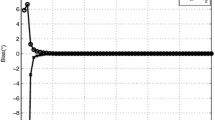Abstract
Making use of the sparsity of targets, three novel direction of arrival (DOA) models based on compressed sensing (CS) theory are proposed. Covariance matrix CS, interpolated array CS and beam space CS carry out compressive sampling on covariance matrix, interpolated array and beam space, respectively. High-resolution DOA estimations are obtained through reconstruction of sparse signal by convex optimization problem resolution. The proposed methods are conceptually different from subspace-based methods and provide high resolution using a uniform linear array without restricting requirements on the spatial and temporal stationary and correlation properties of the sources and the noise. Results of both simulated data and measured data show that these methods are superior to conventional DOA methods in angular estimation performance.


Similar content being viewed by others
References
Baraniuk, R. (2007). A lecture on compressive sensing. IEEE Signal Processing Magazine, 24(4), 118–121.
Bilik, I. (2011). Spatial compressive sensing for direction-of-arrival estimation of multiple sources using dynamic sensor arrays. IEEE Transactions on Aerospace and Electronic Systems, 47(3), 1754–1769.
Candas, E. J., & WaKin, M. B. (2008). An introduction to compressive sampling. IEEE Signal Processing Magazine, 25(2), 21–30.
Candes, E. J., & Tao, T. (2006). Near-optimal signal recovery from random projections: Universal encoding strategies. IEEE Transactions on Information Theory, 52(12), 5406–5425.
Chen, S. S., Donoho, D. L., & Saunders, M. A. (2001). Atomic decomposition by basis pursuit. SIAM Review, 43(1), 129–159.
Cotter, S. F., Rao, B. D., Engan, K., et al. (2005). Sparse solutions to linear inverse problems with multiple measurement vectors. IEEE Transactions on Signal Processing, 53(7), 2477–2488.
Dmitry, M. M., Mujdat, C., & Alan, S. W. (2005). A sparse signal reconstruction perspective for source localization with sensor arrays. IEEE Transactions on Signal Processing, 53(8), 3010–3022.
Donoho, D. L., & Tsaig, Y. (2006). Extensions of compressed sensing. Signal Processing, 86(3), 533–548.
Donoho, D. L. (2006). Compressed sensing. IEEE Transactions on Information Theory, 52(4), 1289–1306.
Figueiredo, M. A. T., Nowak, R. D., & Wright, S. J. (2007). Gradient projection for sparse reconstruction: application to compressed sensing and other inverse problems. IEEE Journal of Selected Topics in Signal Processing, 1(4), 586–598.
Gurbuz, A. C., Mcclellan, J. H., & Cevher, V. (2008). A compressive beamforming method. In Proceedings of the international conference on acoustics, speech and signal processing, ICASSP March (pp. 2617–2620).
Gurbuz, A. C., Cevher, V., & Mcclellan, J. H. (2012). Bearing estimation via spatial sparsity using compressive sensing. IEEE Transactions on Aerospace and Electronic Systems, 48(2), 1358–1369.
Huang, J., & Zhang, T. (2010). The benefit of group sparsity. The Annals of Statistics, 38(4), 1978–2004.
Kim, S. J., Koh, K., Lustig, M., et al. (2007). A method for large-scale regularized least-squares. IEEE Journal of Selected Topics in Signal Processing, 4(1), 606–617.
Kim, J. K., Lee, O. K., & Ye, J. C. (2012). Compressive MUSIC: A missing link between compressive sensing and array signal processing. IEEE Transactions on Information Theory, 58(1), 278–301.
Li, J. (1992). Improved angular resolution for spatial smoothing techniques. IEEE Transactions on Signal Processing, 40(12), 3078–3081.
Liu, Z., Ruan, X., & He, J. (2013). Efficient 2-D DOA estimation for coherent sources with a sparse acoustic vector-sensor array. Multidimensional Systems and Signal Processing, 24(1), 105–120.
Mallat, S., & Zhang, Z. (1993). Matching pursuit with time-frequency dictionaries. IEEE Transactions on Signal Processing, 41(12), 3397–3415.
Pillai, S. U., & Kwon, B. H. (1989). Forward/backward spatial smoothing techniques for coherent signal identification. IEEE Transactions on Acoustics, Speech, Signal Processing, 37(1), 8–15.
Roy, R., Paulraj, A., & Kailath, T. (1986). ESPRIT-A subspace rotation approach to estimation of parameters of Cisoids in noise. IEEE Transactions on Acoustics, Speech and Signal Processing, 34(5), 1340–1342.
Schmidt, R. O. (1986). Multiple emitter location and signal parameter estimation. IEEE Transactions on Antennas and Propagation, 24(3), 276–280.
Stoica, P., & Nehorai, A. (1990). Performance study of conditional and unconditional direction-of-arrival estimation. IEEE Transactions on Signal Process, 38(10), 1783–1795.
Stoica, P., Ottersten, B., Viberg, M., et al. (1996). Maximum likelihood array processing for stochastic coherent sources. IEEE Transactions on Signal Processing, 44(1), 96–105.
Tropp, J. A., & Gilbert, A. C. (2007). Signal recovery from random measurements via orthogonal matching pursuit. IEEE Transactions on Information Theory, 53(12), 4655–4666.
Wang, Y., Leus, G., & Pandharipande, A. (2009). Direction estimation using compressive sampling array processing. In Proceedings of the 15th IEEE workshop on statistical, signal processing, (pp. 626–629).
Xu, X., Wei, X. H., & Ye, Z. F. (2012). DOA estimation based on sparse signal recovery utilizing weighted l1-norm penalty. IEEE Signal Processing Letters, 19(3), 155–158.
Yu, Y., & Poor, H. V. (2010). MIMO Radar using compressive sampling. IEEE Journal of Selected Topics in Signal Processing, 4(1), 146–163.
Zhao, G. H., Chen, B. X., & Dong, M. (2008). A new DOA estimator based on alternating projection and its application in VHF radar (in Chinese). Journal of Electronic and Information Technology, 30(1), 224–227.
Zheng, Z., Li, G. J., & Fast, D. O. A. (2013). Estimation of incoherently distributed sources by novel propagator. Multidimensional Systems and Signal Processing, 24(3), 573–581.
Acknowledgments
This work is supported by National Natural Science Foundation of China (61001209, 61101244), the Fundamental research Funds for the Central Universities (K5051202038) and Program for Changjiang Scholars and Innovative Research Team in University (IRT0954).
Author information
Authors and Affiliations
Corresponding author
Rights and permissions
About this article
Cite this article
Zhu, W., Chen, BX. Novel methods of DOA estimation based on compressed sensing. Multidim Syst Sign Process 26, 113–123 (2015). https://doi.org/10.1007/s11045-013-0239-2
Received:
Revised:
Accepted:
Published:
Issue Date:
DOI: https://doi.org/10.1007/s11045-013-0239-2




